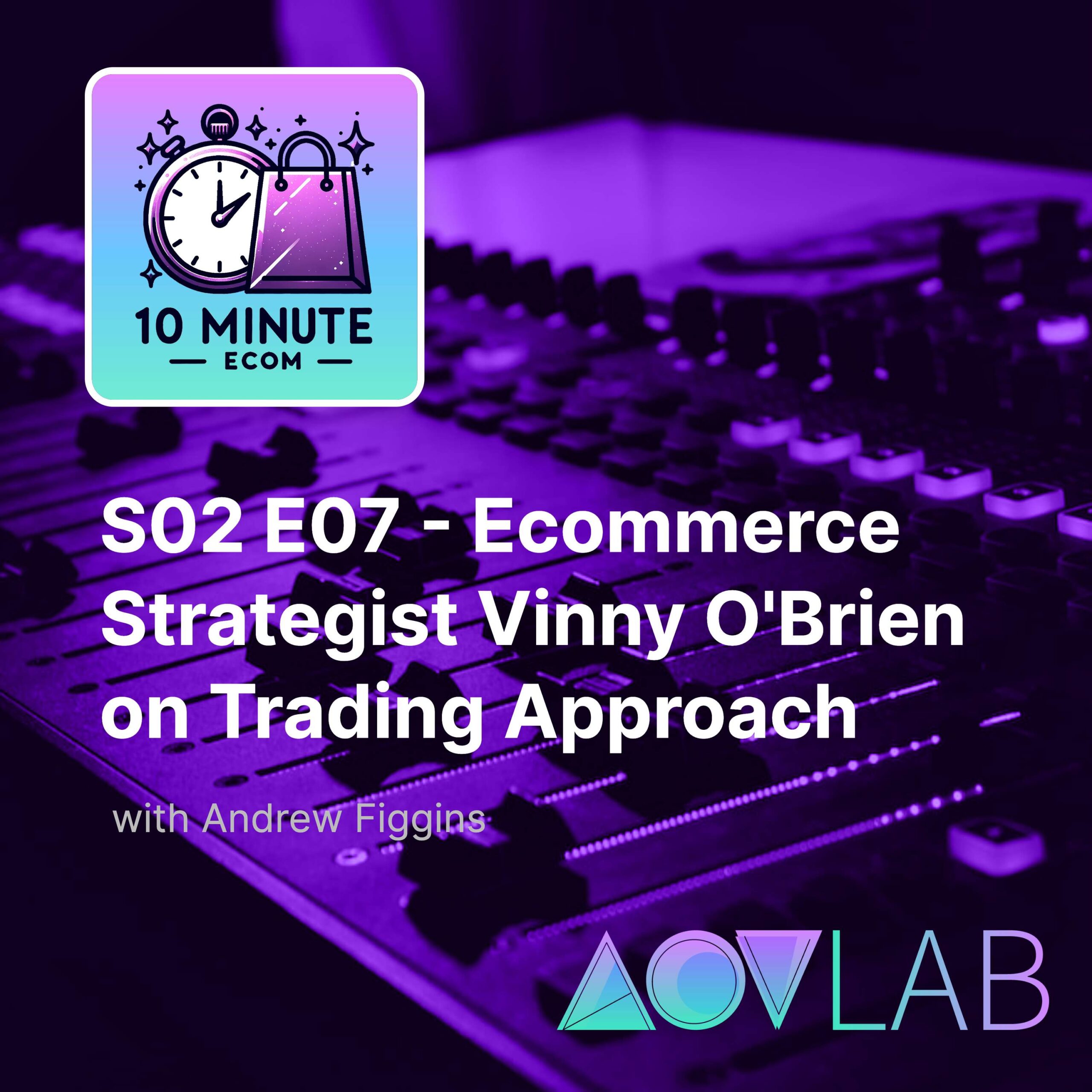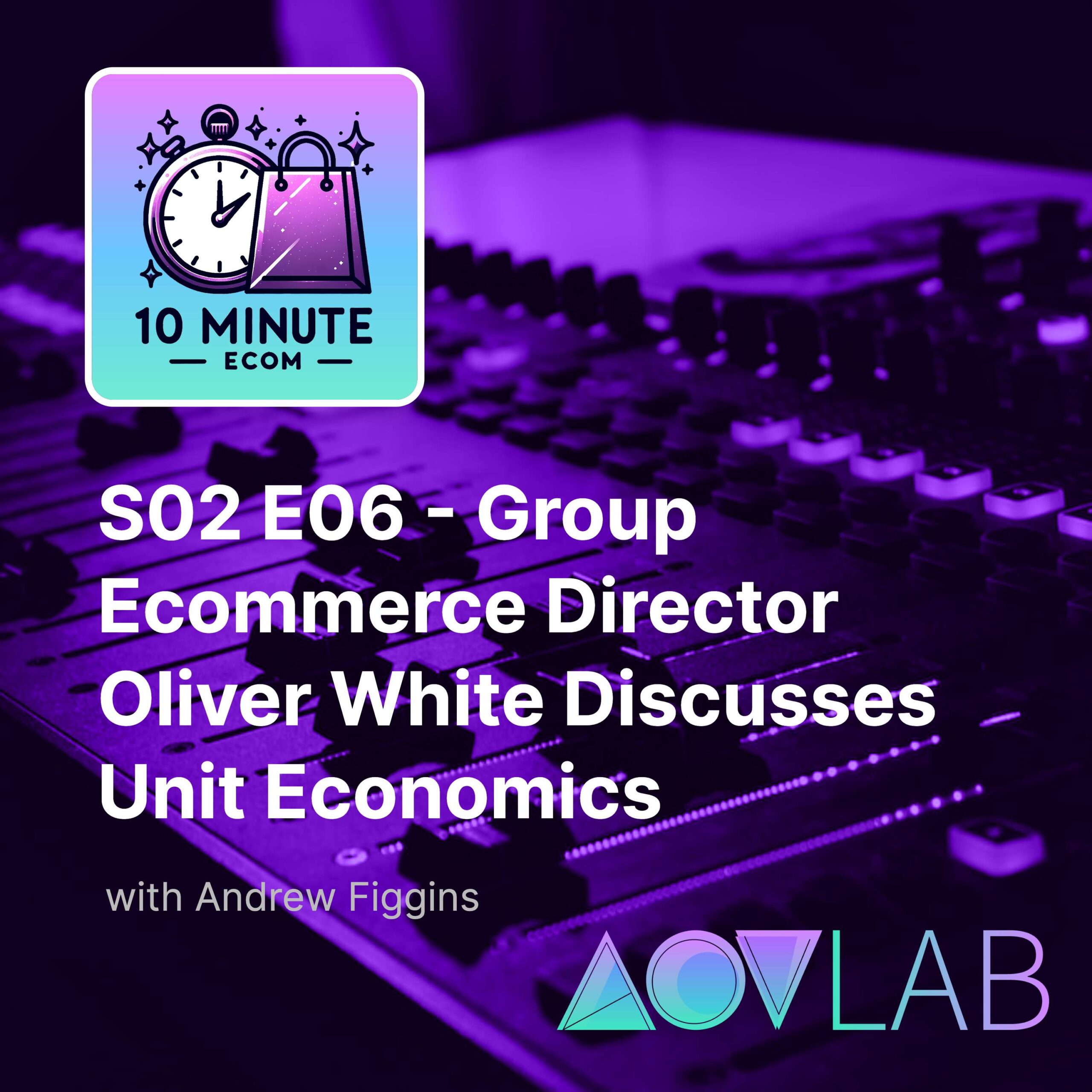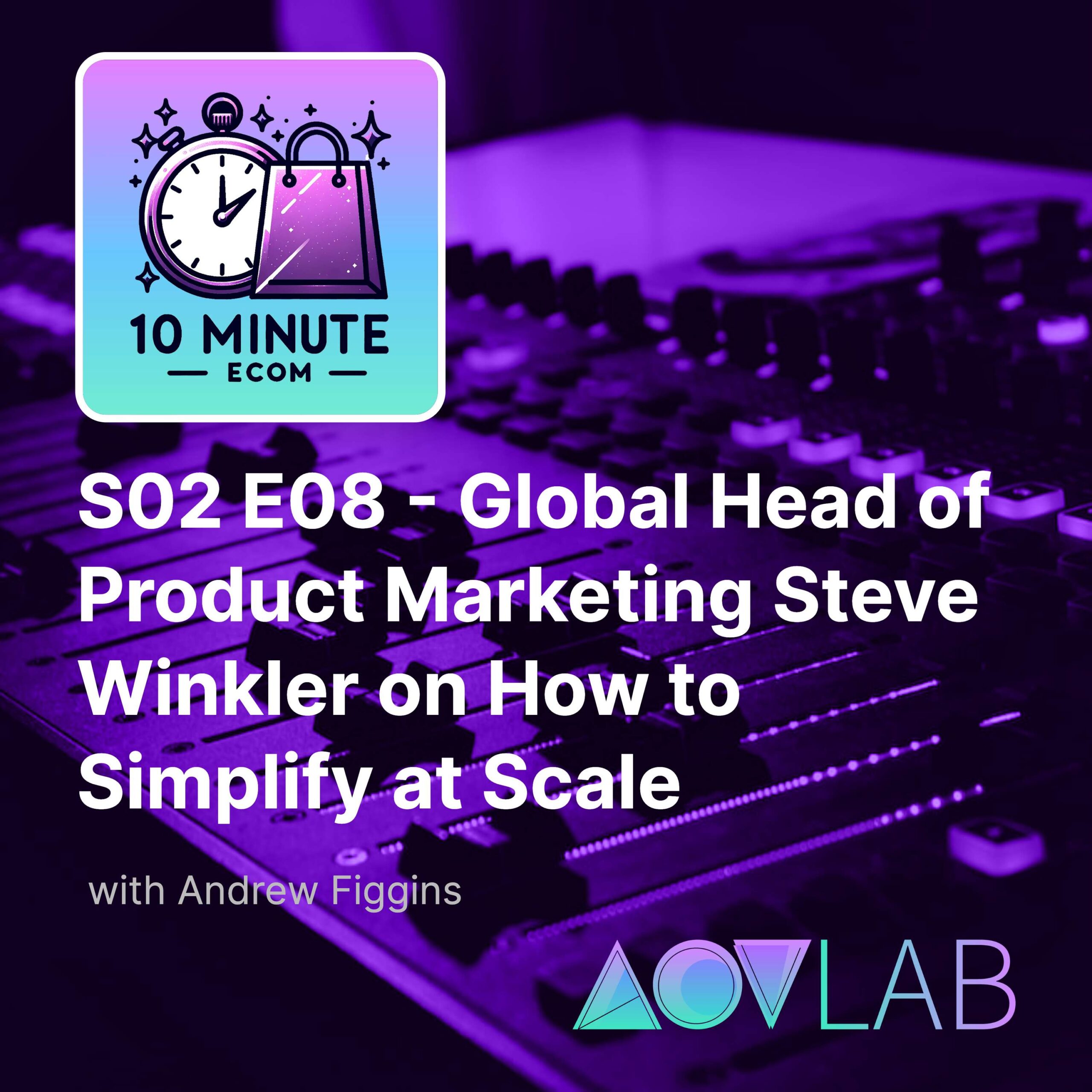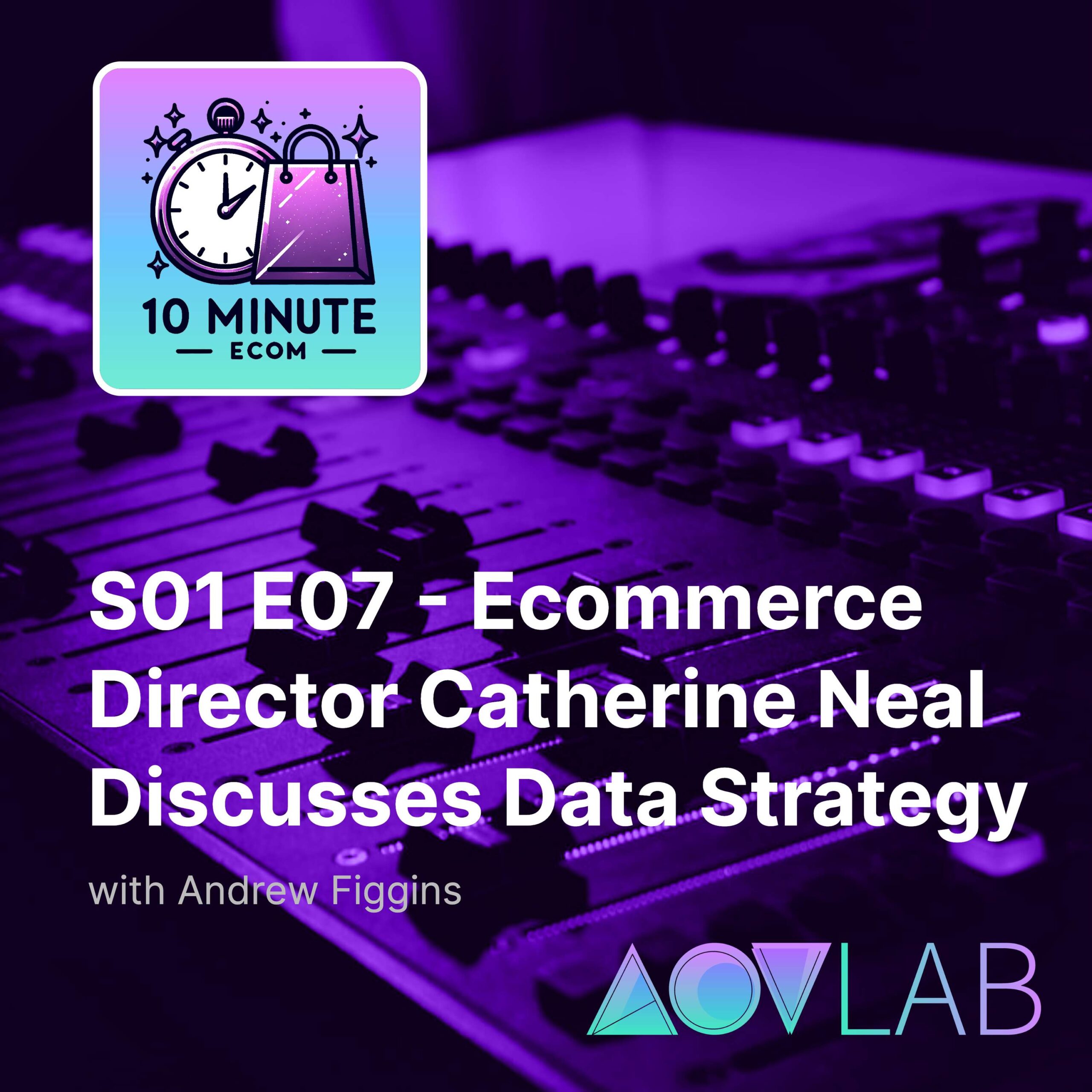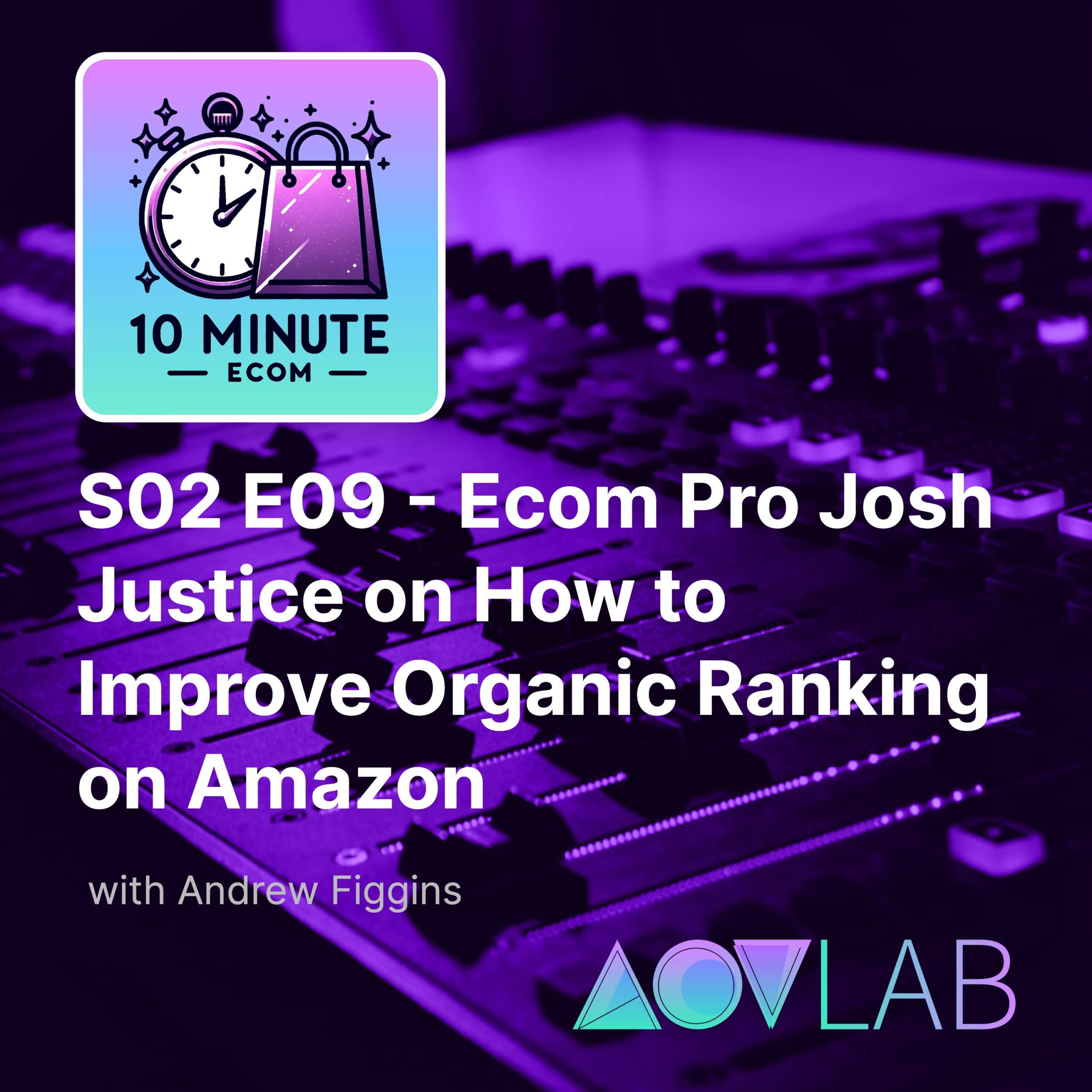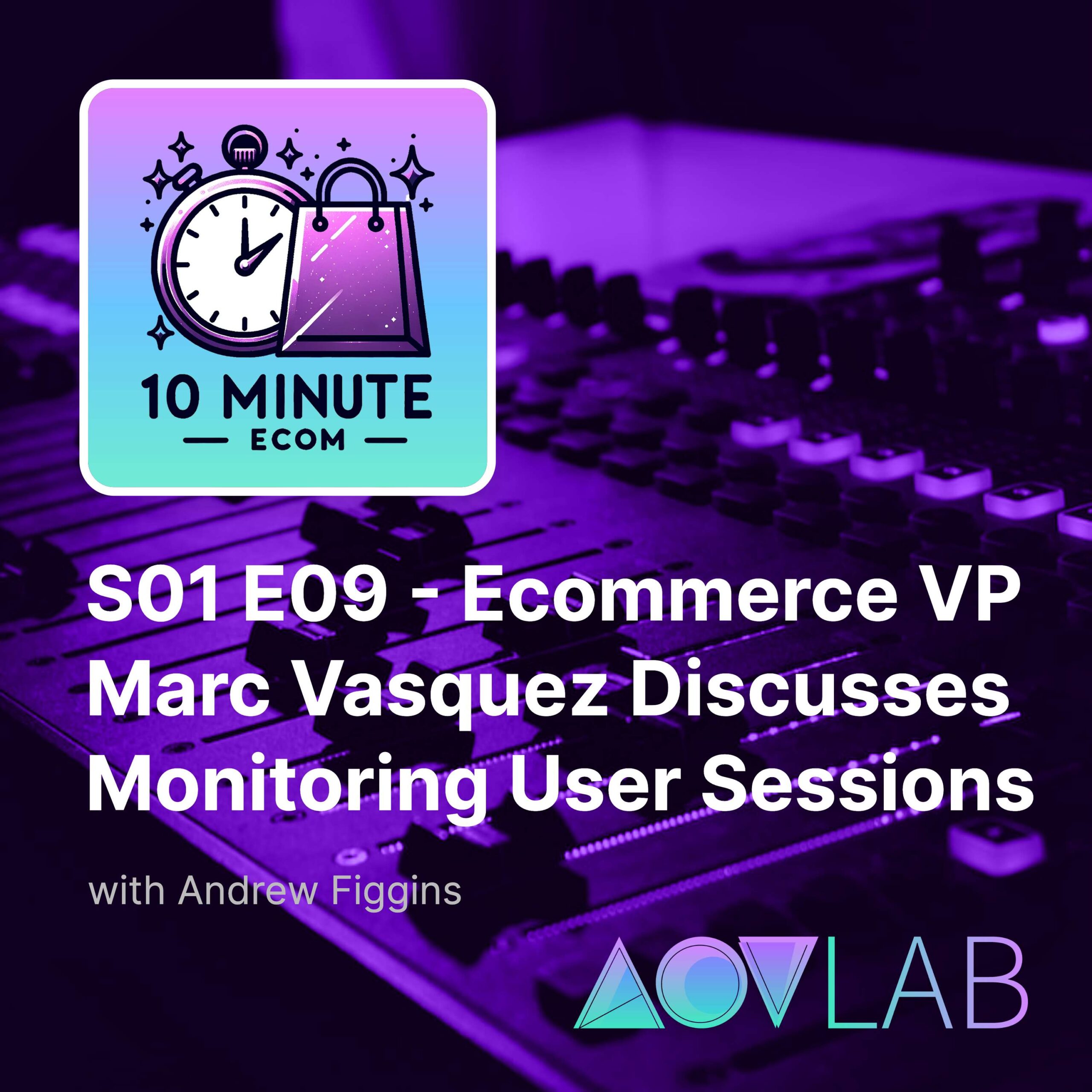View Full Transcript
Episode Transcript
[00:00:07] Speaker A: Hello, ecommerce fans, and welcome to ten minute Ecom and AOV Lab podcast. Every episode, we break down a new and different tactic that can help you improve your ecommerce KPIs key performance indicators. I'm your host, Andrew Figgins. I am an ecommerce professional. You may know me as the founder of AOV Lab, the former vp of product innovation at Scrubs and beyond, or is the former director of e commerce technology at Rural King.
[00:00:33] Speaker B: Today I'm excited to be talking to.
[00:00:35] Speaker A: Vinny O'Brien, an e commerce colleague that is doing very interesting work in e commerce and has a really cool topic that he'll share. Anyway, Vinny, what did you come on the show to share today with your e commerce colleagues?
[00:00:48] Speaker C: Hi, I'm Vinny from crew outdoors. I'm talking to you from Trilly Kerry, Ireland in the southwest. This is where we have our head office, and we also have an office in Austin, Texas. We sell thermally insulated tents, and our market is North America. One of the things that I've used over a number of years across clients and both on our own side, is not so much a tactic, but a grouping of them. And what I wanted to talk to you today about was developing a trading mentality within your team.
[00:01:18] Speaker A: Thank you, Vinny. After the ad, we'll get right into the chat.
Today's episode of ten minute Ecom is brought to you by shop aov lablab.com. It is a brand new store with fun apparel and gear specifically for Ecom professionals just like you and me. We've got high quality embroidered and printed t shirts, hoodies, and hats that will spice up any Zoom call or in person meeting with your team. If you lead a team, these products make for awesome gifts to celebrate hitting a conversion rate or average order value milestone. If you work in ecommerce, I think you'll not only find some humor in these products, but also a sense of pride for what you do every day. Again, the site is shop aov lablab.com. Head over right now and browse while you listen. Unless you're driving. In that case, pull over. You've got to see and share these products one last time.
[00:02:14] Speaker B: The website is shop auvlab.com.
And now back to the show.
[00:02:22] Speaker C: It's a team tactic that we need to employ, but I think increasingly in the current environment, over the next 1224 months, as teams evolve, we're going to need the idea that someone is responsible for the trading role in our businesses, and that's the person who gets out of bed in the morning, looks at the number and says, I'm going to do what it takes to get myself over the line today, knowing that you got a toolkit that's only so big or has the limitations on it and you operate within that. The thing I really like about it and what I'm excited to talk to you about is it's in your control, and most of the things that are challenges today in the environment are outside of our control. This is the thing that we have at our fingertips as teams that we can use on a day to day basis.
[00:03:03] Speaker B: Vidy, thanks so much for coming on the show today. I'm very excited to talk to you about this. Just our topic, really. We were just chatting about it before the recording started, and you were describing this role of a trading person as almost like a business lead.
In a lot of ways. It's somebody who.
[00:03:22] Speaker C: You know what?
[00:03:22] Speaker B: Instead of me trying to describe it, I'll just ask you, could you describe what this role is all about?
[00:03:28] Speaker C: I wish you didn't ask me that. Every time I say to someone, they get me to describe it, and hopefully I'm going to get it right this time. It's the person that comes in every day to pull the strings with the tools that you have in your business to say, okay, what are the things we're going to do today to make the number that we need to? So it's not a strategic role. It is in itself a tactic. It's that person that understands all of the marketing levers that you have, the operational tools that you have, and they understand how to put things in place. So it's not someone who comes up with concepts. They say, this is the thing we're going to do, and this is how we're going to do it today. And that, to me, is someone who also can help develop that mindset throughout the team. And one of the things we were just talking about was you were able to pass that responsibility on to someone else or you had a teammate who knew, today is the day I got to do it. And that, to me, is a really cool tactic, but it's something that we need, particularly, as I said, with the headwinds that we're facing into all the other things outside of our control. This is something that we can do ourselves on a day to day basis, which is the thing that really excites me. And I think from a growth perspective, if you look across our teams, this doesn't have to be someone who's a technical genius or someone who is maybe a commercial wizard. These are the sort of things you can teach to people and we can grow into. And I think that's what kind of makes it exciting, because it could be someone that's junior in your team, it could be an OPS member, it could be someone from marketing that really wants to do something different. And the great thing is you can see the impact by the close of business every single day. You can say to yourself, three things we decided to do today. Two worked. One didn't. Let's investigate what didn't work, and we do more of those things that did work. And that's a cool thing for me. You can really see impact quite quickly.
[00:05:11] Speaker B: I like the idea of it being a junior person that you can train up in that role in one of those individual tactics, because I think we could dive in and talk about some of the things that the person in that role could do to, I don't even necessarily want to say spike business, but to hit that number, like you said, or to exceed that number, because that really is the goal in e commerce.
[00:05:33] Speaker C: Right.
[00:05:34] Speaker B: For those of us who've been in it, and we're watching Google Analytics every day. We're watching our sales numbers. And when we don't meet that same sales number, that usually, in my case, it's been year over year, we don't hit that daily sales number same day of the week last year. So a Wednesday, a year ago to a Wednesday of this week, today or this year, it can become a challenge and it's easy to fall behind. But I love the idea of having somebody that you train up to really understand that we need to hit the number and exceed the number. And there's many ways to do that.
What are some of the ways that you're familiar with, maybe diving a little bit deeper into some of the things that person could do?
[00:06:17] Speaker C: Yeah. So some of your other guests have touched on them, and the most interesting one was moon and forgive me, the name of your guests. When you've got a small catalog, you can sometimes be a little bit put off by merchandising. But the idea of merchandising, I think, is becoming increasingly important when you've got a large catalog or small. So to give you kind of an insight, I work with a pet client of mine who didn't really understand what was going on on a day to day basis or keep driving traffic to the same pages, dry food, wet food, whatever that was. And one of the things we learned within the segmentation, and this was a trading person who came into the business specifically to look at this. They started looking at the customer data that was there, and they realized, based on both, I suppose, the on page behavior, the checkout behavior and the cart behavior, that they were driving different groups of people in at different times of the day. So in the morning what you had was convenient shoppers who were coming in, they were on the way to work, maybe they were sitting on the train, and they said, you know what, I just need to have something at home this evening or tomorrow morning when I get home so I can feed my pets. So I'm going to get whatever you show me once it hits a couple of key things in the middle of the morning, what you had is browsers. And these are people maybe who are not working or have a little bit more time. And they're going, how do I make my pet better? How do I give them a better lifestyle? How do I make their poo smell different? Or whatever that's going to be. Excuse the weird reference, but how do I make them feel healthier is probably a better way of putting it. So they're going to spend a lot of time digging through pages and showing them a wider range of brands and maybe different value options is something that, this is what was uncovered during the process. And then again at lunchtime, we do different audience sets. So the overarching thing that we learned, and as a tactic was we can start displaying different merchandising layers within the landing pages. It also meant that we could change the way that we approach ads on a day to day basis and say, actually, let's activate differently. We go with smaller bursts. It also meant from a commercial perspective, and these are the kind of the outputs of the uncovering, that we could start using smaller budgets across a wider set of ads to drive a better impact for the business. So rather than have much broader ads running for 1220, 4 hours, 48 hours, we now had these smaller ad sets that were actually running for one, 2 hours during a period of a day, guiding people into a specific landing page or a subset of that landing page, so that we could drive better conversion and better ad to basket. And ultimately, if you consider the cycle here, and I'm sure you've done this before, but you were filling both the top of the funnel and the middle of the funnel because you're displaying more product more frequently to people as a business. Some of the other outputs of this were we were sweating more product more frequently. It meant that we could go back to suppliers and get better deals, because now we're pushing product that maybe we haven't done for six months. And it was more useful from a customer perspective as well, because now what you're getting is better experiences. All of this came from a discussion, and this is where it started. From the warehouse manager who came in one morning to the Ops meeting and said, guys, we have 44 pallets over in this side of the warehouse that we haven't touched in nearly three months.
It's going to be out of date soon. Even those dry food, we're going to have to dispose of it. What do you guys want to do with it? And that sparked a discussion for one of the teams to go away and start investigating the segments and performance of pages. And when you think about all the things that are incorporated there, there's four or five different roles involved, but it is something that's in one person's control. And then you can start talking to all the different people, and if you've got agencies involved, you can describe the behaviors that you want to elicit from people as well. So overall, what it meant was, we're getting a better result. And I think you can use that same approach no matter what size business you're in. Big, small and in the moon example. It was really good to see they were testing different commercial propositions, which is going to be so important this year, because customers want to see value, they want to see difference. They don't want to come back and see the same thing over and over again. So I really loved hearing that, that with a small catalog of four products, that you could see such a unique merchandising proposition, and it really gave me heart. That's one example that kind of sprang to mind.
[00:10:32] Speaker B: I love how many levers there are in ecommerce. Right? Like, we've talked about a few of them already. I think that relationship between suppliers and the retailer or the brand, super important. The warehouse you mentioned just having that connection and that connectivity between the ops team and all the different areas of the business. And in my experience, it's been a warehouse leader and maybe an internal operations leader, a merchandising leader, a marketing leader. But I think that it lends itself in some cases. Maybe it's more of for us based companies, I'm not sure, but almost like this is my room in the house kind of mentality, and there's not a lot of common area. It's not like everybody comes down to the living room once a day to really sort it out. But I like what you're sharing today because it's almost like a little framework for the folks in charge of each area to sort it out, and to have that give and take and push and pull to really figure out what's it going to take for us to beat the number today. I think you've got something pretty special here, Vinny.
[00:11:43] Speaker C: Look, it's born out of necessity. I think when I worked with smaller organizations, you had to be in that position where you were prepared to do lots of different things. When I worked at eBay, we sold all the time. And on the sales side, the best story I ever heard was we had a guy in the Isle of Wipes off the mainland of the UK, and the rumor was he sold windscreen wiper blades, windshield wipers. And the rumor was that he was using, and this is in the mid 2000s, he was using data from the med office to understand how likely there was going to be rain on any given day. And he was on an island, it rained a lot. And his gut feel was that when it rained, he sold more wiper blades, which kind of makes sense, but people were in that mindset of thinking about it. So he used an API. Back in the day, he started saying, when the likely chance of rain goes above a certain percentage, automatically adjust my pricing to a certain level, because I know I'm going to sell more. And over the course of the year, he was eBay Seller of the year. That particular year, I think he increases sales by about 25% to 30%, somewhere in that region. And it was just fascinating to see how he's able to use the gut feel led by data to make this change. And then on the other side, I worked in an after parts business where we get in and we use that story to inspire us a little bit. But our problem was returns. So every Friday we had this discussion. Our warehouse manager would come up and kick our butts and say, guys, why do we keep having all these returns?
We didn't really have a reporting mechanism for people to understand how returns were coming in. We always just put the insert into our packaging and that just went into trash. So that wasn't really any use to us. So we started doing this follow up. What we uncovered from it were a couple of things. One, we started understanding the reasoning. We were able then to identify that the reason for a certain product was linked to a specific brand. So we now were able to feedback to the supplier and say, hey, we've got a problem with your brake pads. And that was a specific example we were able to go back with. What that meant was we were able to cut that product off, replace it with another supplier to give us a better quality of product. We didn't get the returns right and we were able to use that functionality every week. And that meant we're getting better experiences, meant our warehouse felt like they were being listened to, and also for the problem areas. Being able to go back to suppliers, even as a small manufacturer, it meant that we were able to control things like product rebates, because now we were doing a monthly cycle rather than leaving it six, nine, maybe twelve months to do a stock take. And then we realized, holy crap, there's 50 grand's worth of product sitting in the corner of that. We should have been able to move during the year, and now we've got to get it out the door. We now hope our suppliers are going to help us with a rebate or take the product back from us. So by going through this weekly cleanse, it meant that we had a much more efficient business. And I love that idea within this tactic set and within this trading mentality, that you're also responsible for the cost control within your business as well. And that's going to be as sexy as growth, I think, in 2024, it's being able to manage those costs. So this little forum that we had this Friday minute get together, where someone brought the tea and biscuits, meant that we had this area that we could talk safely. And it was really a practical discussion. It wasn't my metrics out, so I'm going to kick your butt. This is what's happening. How can we solve it? And small businesses, sometimes that works well because you have to, it's a necessity. And I don't know if that's the same in some of the orgs that you've worked in, but I see that the problems just, they grow depending on the size of company that you work with. I'm consulting into one of the biggest brands in the US right now, and they have the same kind of problems, but they are magnified just because of the sheer size of the business. So their ability to stop that at source is much more challenging just because of the complexity of people and the discussions. And funnily enough, no one owns this trading space either.
[00:15:26] Speaker B: I think that's common. I think it's viewed vertically, I think within a lot of these organizations, whereas I think what you're saying in some regards is to really make it more of a horizontal thing, even out the playing field for the different areas, but give someone that ability to hear what's going on in each area of the business and then make that decision on a daily basis and say, okay, today, if maybe our conversion is off 10%, what can we do to make up that 10%? You were saying before we started recording today, maybe a way to do that is to go back to the supplier and say, look, I'm going to need a 10% break on cost over the next 30 days just to hit the number. But there's so many levers that can be pulled.
[00:16:09] Speaker C: I think so. And from the supplier relationship point of view, it's great that someone that's proactive enough to pick up the phone and say, hey, help me out here, because you have a chance at least to solve a problem if it's left till month end or quarter end. You're then talking about money, which is not really in anyone's interest. But I think if you're able to pick up the phone, you strengthen relationships. And that horizontal approach that you talk about to me, that's necessary. You need this person floating between departments to understand what's going on. And they get to know the people that they're working with as well, which I think is really important. And from a workflow point of view now, where a lot more of us are remote and in these areas where we feel a little bit siloed, that person is so important. And the great thing is it doesn't need to be two, 3 hours of a meeting. It can be a quick ten minute stand up every morning to say to people, what's stopping you doing your job today? How can I make it easier for you? What do we need to do? That cumulative effect over a trading period of twelve months is so, so impactful. And the great thing is you can change it from day to day. As we said, you might say, guys, we haven't even segmented emails in ages, or cart abandonment just isn't working anymore. Can we switch it up? Can we go to manual emails and stop doing the automated approach because people are biting? Why don't we look at the address that, the address that they're coming from? And this is something that we have in our crew of business, the tent business. We turned off cart abandonment as an automated feature just before Black Friday. And we focus on basket sizes above, I think it was $1,000 up to 4000. And we empowered the team to say, look, you use within this margin set, you use any tactics that you want to try and capture that sale because we know that it's going to be worth it to us over the longer term. And that empowerment meant that we didn't have to check on people every day. We didn't have to look at monthly margin reports because we knew that was all in there and it was empowered in people, and it was great because you're looking at people trying to convert and they might be in, I don't know, they might be in Philadelphia. And the Eagles are beaten last night, and you can say, tough luck, eagles. Not that you get the same version.
[00:18:08] Speaker B: Goes down.
[00:18:10] Speaker C: Yeah. So, look, it just meant there was a little bit of human element going on in there, and it really helped rise the conversion rate over cart, abandonment, emails.
[00:18:18] Speaker B: Excellent, vinny. And this is ten minute ecom. It's a brief show. We don't have a whole lot of time here, but I wanted to ask you, before we head off today, is there anything else that you'd like to share with your colleagues and peers in ecommerce?
[00:18:33] Speaker C: Yeah, I think it's keep an open mind. I think one of the best tactics that I've picked up over the last ten or 15 years is being open to seeing what other people are doing. Another great thing to do is walk the shop floor. So come in every morning, check your links, check that merchandising is good, check that ads are running, all those little basic things. And then the other thing is have a look at what competitors are doing. There's only a certain number of things we can do in e commerce to get this right. And the way that I approach it, and this is how I leave it, is that stop, start, do more of. So stop doing the things that you see repeatedly don't work. Start doing something new to test. And you talked about a b testing and that as a tactic, and then do something new. So what are those things that you want to test yourself within the business and, sorry, do more of, I should have said was the final part. Do more of the things that repeatedly work and use them and amplify them and make sure then that you measure them and see what's the point at which maybe you need to change it up. So stop, start and do more of would be my final tactic to anyone.
[00:19:31] Speaker B: Who'S listening, really appreciate your time, Vinny. I'm tempted to change the name of the show.
[00:19:37] Speaker C: I think it might need to be.
[00:19:38] Speaker B: 20 minutes ecom or 30 minutes ecom today just because you've brought so much awesomeness to the show and in depth knowledge. So really appreciate your time again.
[00:19:48] Speaker C: Thank you so much. And that will just give you twice the work. So I'd avoid changing it up. Just put people like me off and say, you talk too much.
[00:19:55] Speaker B: No, it's an easy edit today.
[00:19:57] Speaker C: Vinny, awesome, Andrew, look, I appreciate your time and we'll talk again over the coming months, I hope.
[00:20:03] Speaker B: Awesome.
[00:20:04] Speaker A: Well, we have hit that ten minute mark times two, so that's a wrap for today's episode. I want to again thank our guest Vinny O'Brien. If you have a moment, be sure to subscribe like or follow the show on Apple Podcasts, Spotify, Amazon Music, Google podcasts, or wherever it is that you listen.
As mentioned earlier in the episode, please head on over to shop AOV Lablab.com, our brand new store that helps to support this podcast. It is launching with nearly 100 products, so plenty to choose from. Our top seller so far is a shirt that simply says Ecom on it. I wear it around my extended family so I can point to it when my relatives ask me what I do.
I hope you enjoyed this episode of the show. Until next time, this is Andrew Figgins signing off and saying have a good one.
